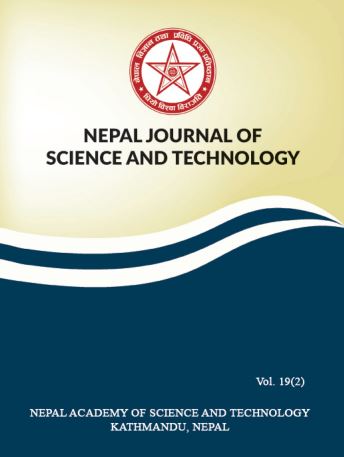Phytochemical Screening and Evaluation of Antimicrobial and Antioxidant Activity of Mahonia napaulensis (Jamanemandro) Bark Extract
DOI:
https://doi.org/10.3126/njst.v20i1.39429Keywords:
Mahonia napaulensis, screening, antioxidant, DPPH radical scavenging, IC50Abstract
Mahonia napaulensis also known as “Jamanemandro” in Nepali is a medium-sized stiff evergreen shrub widely distributed in South East Asia at an altitude of 1000-2000m, is traditionally used to treat dysentery and eye inflammation. This research focuses on screening of the phytochemicals, antimicrobial, and antioxidant properties of this plant. The methanolic extract was prepared using a Soxhlet apparatus. The antioxidant properties of extract were carried out by 50% inhibitory concentration (IC50) values from 2-2-diphenyl-1-picrylhydrazyl (DPPH) radical scavenging. The phytochemical screening confirmed the presence of terpenoids, reducing sugars, tannins, alkaloids, glycosides including cardiac glycosides and steroids. The antimicrobial activity was studied using the disc diffusion method in five different human pathogens named Escherichia coli, Staphylococcus aureus, Pseudomonas aeruginosa, Salmonella typhi, and Shigella spps. The methanol extract was compared with standard chloramphenicol and showed that methanolic extract of is M.napaulensis exhibit maximum effect against S. aureus with higher growth inhibition zones (27.3 mm), followed by P. aeruginosa, Shigella spps., E. coli and S. typhi. These antimicrobial properties showed similar effect to that of positive control, chloramphenicol. The IC50 values from DPPH radical scavenging were 230.89 µg/mL and 182.73 µg/mL of methanol extract and ascorbic acid, respectively. Due to this antimicrobial and antioxidant properties of M. napaulensis it was widely applicable in biomedical field.
Downloads
Downloads
Published
How to Cite
Issue
Section
License
Copyright (c) 2021 Ranjan Paudel , Rabi Kiran Sharma, Shreeya Bhandari, Manan Koirala, Ganesh Bhandari, Netra Lal Bhandari

This work is licensed under a Creative Commons Attribution-NonCommercial 4.0 International License.
Authors retain copyright and grant the journal right of first publication.




